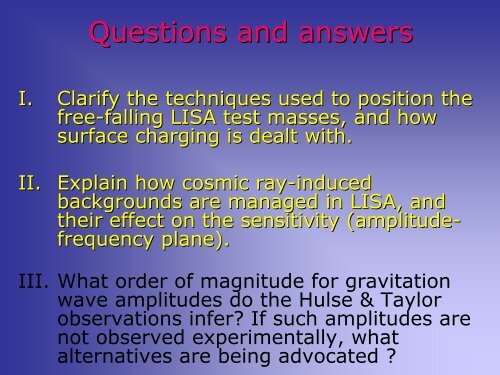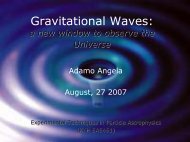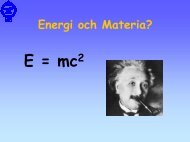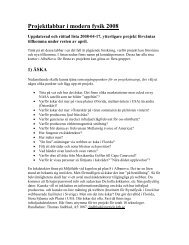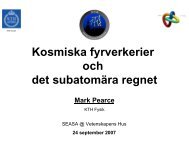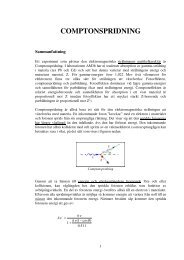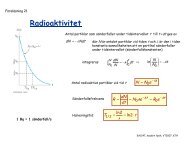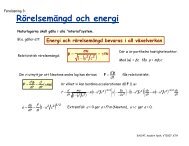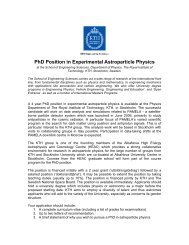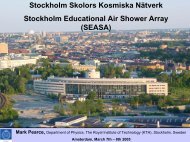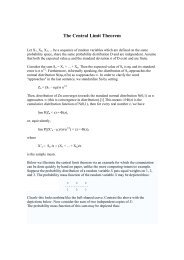Gravitational Waves: a new window to observe the Universe
Gravitational Waves: a new window to observe the Universe
Gravitational Waves: a new window to observe the Universe
Create successful ePaper yourself
Turn your PDF publications into a flip-book with our unique Google optimized e-Paper software.
Questions and answers<br />
I. Clarify <strong>the</strong> techniques used <strong>to</strong> position <strong>the</strong><br />
free-falling falling LISA test masses, and how<br />
surface charging is dealt with.<br />
II.<br />
Explain how cosmic ray-induced<br />
backgrounds are managed in LISA, and<br />
<strong>the</strong>ir effect on <strong>the</strong> sensitivity (amplitude-<br />
frequency plane).<br />
III. What order of magnitude for gravitation<br />
wave amplitudes do <strong>the</strong> Hulse & Taylor<br />
observations infer? If such amplitudes are<br />
not <strong>observe</strong>d experimentally, what<br />
alternatives are being advocated ?
• proof masses have a double role:<br />
1 - mirrors for <strong>the</strong> interferometer<br />
2 - inertial references for <strong>the</strong> drag-free<br />
control system.<br />
• The drag-free control system consists of:<br />
1 - inertial sensor<br />
2 - proportional micro-propulsion system<br />
3 - control loop
• The displacement of <strong>the</strong> cubes with respect <strong>to</strong> <strong>the</strong>ir<br />
housing is measured by capacitive sensing in three<br />
dimensions.<br />
• These position signals are used in a feedback loop<br />
<strong>to</strong> command proportional micro-propulsion<br />
thrusters <strong>to</strong> enable <strong>the</strong> spacecraft <strong>to</strong> remain<br />
centered on <strong>the</strong> proof mass.<br />
• Field Emission Electric Propulsion<br />
(FEEP) thrusters<br />
will be used<br />
as actua<strong>to</strong>rs.
• cosmic rays and solar flare particles can<br />
significantly charge <strong>the</strong> proof mass surfaces<br />
(see “Cosmic-ray spectra near <strong>the</strong> LISA orbit”,<br />
Grimani et al. 2004 Class. Quantum Grav., 21<br />
S629)<br />
• A system of fiber-coupled UV lamps will discharge<br />
<strong>the</strong> proof masses at regular intervals<br />
• In order not <strong>to</strong> damage <strong>the</strong> coating during<br />
launch, a caging mechanism is used <strong>to</strong> maintain<br />
<strong>the</strong> proof masses in a safe position during launch.
Questions and answers<br />
I. Clarify <strong>the</strong> techniques used <strong>to</strong> position <strong>the</strong><br />
free-falling LISA test masses, and how<br />
surface charging is dealt with.<br />
II.<br />
Explain how cosmic ray-induced<br />
backgrounds are managed in LISA, and<br />
<strong>the</strong>ir effect on <strong>the</strong> sensitivity (amplitudefrequency<br />
plane).<br />
III. What order of magnitude for gravitation<br />
wave amplitudes do <strong>the</strong> Hulse & Taylor<br />
observations infer? If such amplitudes are<br />
not <strong>observe</strong>d experimentally, what<br />
alternatives are being advocated ?
What order of magnitude for gravitation wave<br />
amplitudes do <strong>the</strong> Hulse + Taylor<br />
observations infer?<br />
PSR B1913+16<br />
d = 6.44 pc --> about 0.1 – 1 Hz<br />
h ~ 10 -18 –10 -20
The gravitational waves are described by:<br />
Frequency, ν<br />
Type Range Run Time Sources Instrument<br />
HF<br />
10 Hz →<br />
1000 Hz<br />
one per day<br />
Compact<br />
stars<br />
bars, LIGO,<br />
VIRGO<br />
MF<br />
0.1 Hz →<br />
10Hz<br />
one per<br />
a few days<br />
NS binary<br />
inspiral<br />
Advanced<br />
LIGO<br />
LF<br />
10 μHz →<br />
10 mHz<br />
one per year<br />
binaries<br />
SMBHs<br />
LISA<br />
VLF<br />
1 nHz →<br />
10 μHz<br />
once in a<br />
lifetime<br />
cosmic<br />
astrophysics<br />
PTA<br />
ULF<br />
10 nHz →<br />
0 Hz<br />
snapshots<br />
only<br />
cosmic<br />
structure<br />
COBE, MAP<br />
Planck, etc.
If such amplitudes are not <strong>observe</strong>d<br />
experimentally, what alternatives are being<br />
advocated ?<br />
From <strong>the</strong> Occam’s razor:<br />
“entia non sunt multiplicanda praeter necessitatem”<br />
(entities should not be multiplied beyond necessity)<br />
Actually, any <strong>new</strong> alternative has been<br />
formulated <strong>to</strong> explain <strong>the</strong> orbital period decay<br />
of <strong>the</strong> Hulse & Taylor pulsar!


